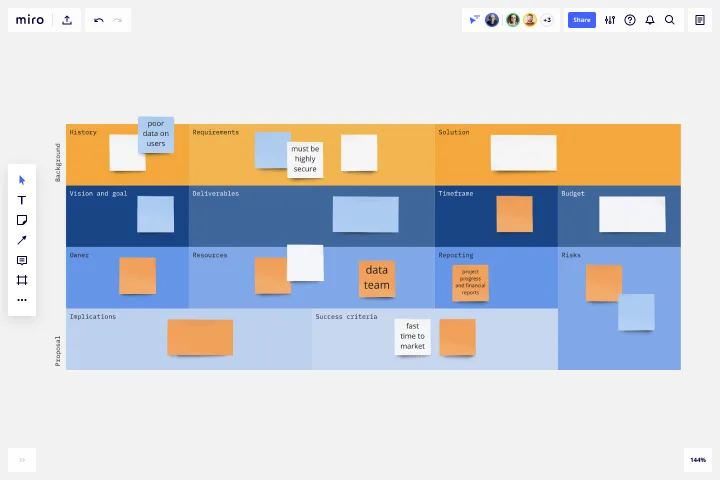

Get buy-in from stakeholders and organize your ideas before a project.
A project proposal outlines what you want to accomplish, your goals, and how you plan to achieve them. Generally, a project proposal gives the reader some context on the project, explains why it is important, and lists the actions that you will take to complete it.
Project proposals have myriad uses. Often, businesses use project proposals to get external buy-in from a donor or outside stakeholder. But many companies draw up project proposals for internal buy-in too.
A project proposal needs to be holistic in order to be effective. Not only is it important to include what you will be doing, designing, or executing on, but it is also important to show why a project is important. This means including background information on a project, the implications of the project, and what has already been done. A proposal should answer what the project is, why it matters, how the project will get done, and who would be involved.
Project proposals are vital. They are the scaffolding of any professional endeavor. Before investing resources in a project, a project proposal can be effective in assessing the value of a potential project. This type of document is especially helpful in communicating ideas to clients and outside stakeholders that need to better understand the concept and scope of a project.
An executive summary is like an abstract before a paper. Use the executive summary to explain the project -- but also to get buy-in. Think of it as an elevator pitch. Tell your reader why you’re undertaking this project, what you’re doing to succeed, and what success will look like.
Give your reader a brief history. Tell them about similar projects you’ve undertaken. If you’ve never undertaken this kind of project before, tell them why now is the time to do so. Show the reader how you’ve learned from prior projects to optimize for success on this one.
Remember, the goal of a project proposal is to get buy-in. Tell your reader what you need to be successful. That could include resources, money, materials, and personnel.
Start by telling the reader exactly what problem you aim to solve. Explain why you think it’s important to solve that particular problem. Frame the problem as an opportunity. It’s not just a hurdle -- it’s a potential market. Then make a case for your business. To win over your reader, persuade them that your project is uniquely suited to solving this problem. Highlight any project management techniques, skillsets, and resources your company is bringing to the table. Don’t be modest!
Sketch out an estimate of how long this project should take. Include some milestones that, once achieved, will let you know that the project is on track. And let your reader know how much it will cost to undertake this project. Be sure to explain how and why you plan to spend that money.
Clarify the internal stakeholders who will be managing the project. That way, the reader will know who to contact if they want to partner with your business or learn more. You can also clarify external stakeholders who must sign off on the project.
When you finish the project, how do you plan to tell the world? Tell your reader how your audience will be impacted by your project and how you plan to communicate that impact. If you have a marketing team, collaborate with them on this section. They should include any documentation, press releases, emails, ads, and social media campaigns they plan to run when the project is finished.
Many people include an appendix that does a deep-dive into the information from the proposal. You can use the appendix for technical documentation or statistics that would bug down the proposal itself, but that might interest your reader.